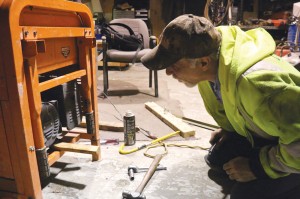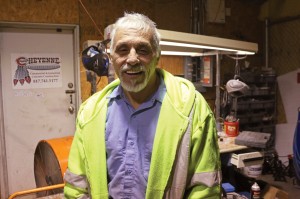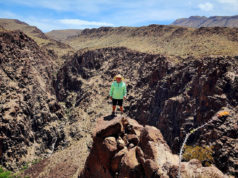One challenge the program faces is recidivism back into homelessness and vagrancy.
Doeren agreed that it’s disappointing when she sees faces she’s interviewed and worked with back at the shelter: “Once they’re out of the shelter, they’re in the wind, unfortunately. But I have the model set up for mentors if they want one. The mentors sign on for a year to check on them on a monthly or weekly basis, but they have to provide a report. Right now, the reporting mechanism is still getting built into our database, so the reports are handwritten, which is often tough to keep up with. And some of the clients don’t want a mentor –– a lot of our clients are in their 40s, 50s, and 60s. They’ve been on their own for a long time, and they don’t want some younger person checking up on them.”
Moreover, the program is designed to foster self-sufficiency: “I want to help these people. I want them to have success and achieve their goals. But I’m not their mom.”
McCarthy agrees. “We want to find and work with those who genuinely want to change their lives.”
Leg Up officially incorporated as a nonprofit in April, though the organization has been in operation for over a year. Bennie Grisham is its first success story. The 51-year-old mechanic has been employed at Cheyenne Construction for a year, saving the concrete builder thousands of dollars a month fixing its busted equipment.

“They were spending between 10 and 15 grand a month replacing things,” Grisham said. “And now I’ve helped cut that cost by a lot,” he said, smiling.
Grisham entered the program after moving to Fort Worth in 2008. He had lived in Las Vegas doing construction, but as the recession hit, the work dried up. He hopped on a bus to Texas: “When I got here, it was cold! I called some shelters, but they were full. I ended up sleeping under an overpass my first night in Fort Worth. The next morning, I talked to the shelter coordinator, but I was still out on the street for, like, three months.”
He got by as best he could, eating at the Union Gospel Mission and Salvation Army: “It got to where I didn’t know if I could keep doing that. Finally, I got into the shelter’s groundskeeping program, and later, through a temp agency, a job at Waste Management,” where he worked for two years.

“My case manager told me there might be a better job opportunity with Toby Owens, so I met with him, and he directed me to [Doeren] … who told me I was going to be the ‘poster boy’ for the Leg Up program.”
Though he already had the job at Cheyenne, he agreed to go through Doeren’s life-skills coaching program: “I wanted to set a good example for other people getting into the Leg Up program, even though I already had a job.”
The process was new to him, but he enjoyed the learning the basics of setting goals and acquiring and keeping a job.
Since he completed the Leg Up program, Grisham’s life has improved dramatically. Part of his woes stem from a pair of out-of-state DUIs from a decade ago, but those fees are nearly paid off. It’s not perfect –– he is currently living in a motel room –– but he anticipates being able to move into a new apartment soon. The location: near Parker-Browne –– next month, McCarthy is going to move Cheyenne Construction and Leg Up into the third floor and Got You Covered into the first and second floors, creating “the Cabela’s of uniforms,” he said.
But the road out of the street for Grisham needs to end with a permanent residence, and that remains a challenge.
Doeren said that of the 27 clients she’s placed who still have their jobs, nearly 10 of them still live at the shelter: “The fact of the matter is that getting housing assistance for the Leg Up clients is almost impossible. The housing vouchers available are for individuals with disabilities or dependents, and most of my clients have neither. Last I checked, the housing authority had over 14,000 applicants, with a comparatively fewer number of homes, 5,000. So the waiting is extraordinary. Housing is something that, once I get the staff, I’ll be able to do a more tactical execution of the program. It’s definitely a Phase 2 of Leg Up. I think our long-term success rate will be a lot higher if we provide that support.”
Leg Up ultimately wants to establish a concrete path to housing, but Doeren agrees that to get the housing channel working, her clients probably need greater accountability: “The housing piece, we’re calling it ‘temporary supportive housing,’ because they would have to have that kind of accountability person, and it needs infrastructure built into the housing unit. We’re not quite there yet.”
Still, there’s plenty of good work to be done. Doeren said that the 2016 budget will allow them to scale their services to two other organizations in addition to Presbyterian Night Shelter. This will require hiring another case manager, but the goal is to serve 180 clients. To those aims, they are raising money to match a $50,000 matching grant from a private donor, in addition to the money that Bob McCarthy has spent on his own as the organization’s primary benefactor.
Doeren wants to help as many homeless people as she can, but like the milestones she sets for her clients, she knows that the Leg Up program has to pace itself to be totally effective: “The model is scalable, but I don’t want to grow it too fast. I want to do it smart, deliberate, with right people who have right temperament and self-guidance.”
In addition, Leg Up recently formalized a partnership with Tarrant County College to bring people to fill their middle-skills certification courses. The inaugural course is wastewater management.
Tarrant County Work Force Solutions told Leg Up that in five to 10 years, Tarrant County is not going to have the right people with the right experience and certifications to work on the underground pipes that keep water flowing into homes. So Leg Up won a grant to cover all of the program’s tuition, as well as the hiring of a part-time person to serve as academic liaisons and tutors for the certification students.
Per the Leg Up program, so-called “soft-skills” training is recommended as part of the class. “Soft skills are making eye contact, being on time, not telling your boss off. … Those scholarships have to be filled over the next 18 months, so we’re pulling groups of 10 every 90 days that are out-of-school youth” –– ages 18-24 with a high school diploma or GED –– “out of the Boys and Girls Club, Cassata High School, Fort Worth ISD Success Academy … basically, students who are at-risk for homelessness or incarceration. Teaching them soft skills and life skills gives them a better chance of beating those odds. Our ultimate mission is to end and prevent homelessness through advocacy, success, and friendship and reaching out to people before they fall into homelessness is part of that.”
Of course, the Leg Up program is not the only organization striving to change homeless people’s lives –– Day Resources, the Salvation Army, Union Gospel Mission, a new organization called True Worth, and others all contribute to solving the problem. But on East Lancaster, the Leg Up program specifically gives Toby Owen hope. While putting 27 out of 2,000 people to work might seem like drop in the bucket, it’s still a significant step, producing real results.
“Being homeless is not a black hole,” he said.
Bennie Grisham is proof of that: “I just wanted to do what I love, to fix things, and now, because of Leg Up, I get to do that.”
It’s a goal he accomplished by using the program to fix himself.












Love these people.